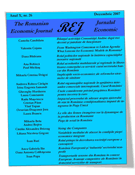Abstract:
This paper examines whether Nigeria witnessed considerable savings mobilization amidst financial sector reforms from 2007 to 2015 using the estimation method of Autoregressive Distributed Lag. Unlike previous papers in this area that mostly focused on interest rates liberalization thesis, this paper goes deeper by looking at financial reforms across money, capital and foreign exchange markets. The estimation results show that there are still structural rigidities in the money, foreign exchange and equity markets nexus. In that, the following variables that proxy financial sector reforms namely treasury bill yield, interest rate spread, market capitalization ratio and currency in circulation ratio (which proxy technological modernization of payment systems) all went against a priori expectation. However, financial reforms had one success story in credit/loans advances to private/public sectors (financial deepening) which posted its correct economic sign. In sum, except for the financial deepening variable it can be safely concluded that financial reforms in Nigeria is yet to positively impact savings mobilization. The regulatory and reform authorities must show effectiveness in reforms implementation.
